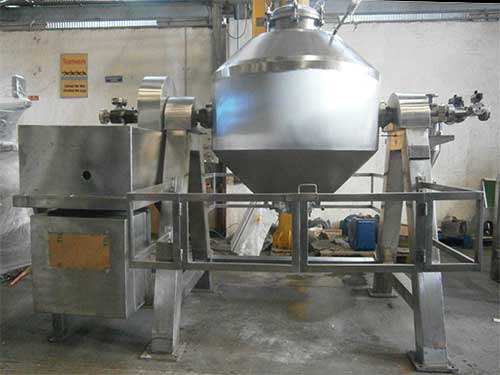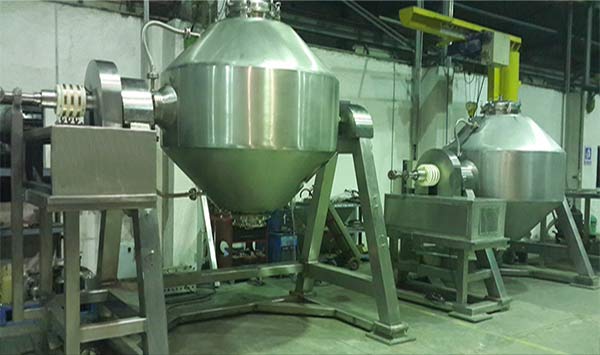ABOUT ROTARY CONE VACUUM DRYER (RCVD)
The Rotary cone vacuum dryer as the name suggest is used to produce homogeneous solid-solid mixture. The biggest advantage of the equipment is that it doubles up as a dryer along with a blender. Even hydroscopic material upto 22% moisture can be dried along with blending. The entire operation is under vacuum and a jacket is provided for heating or cooling depending upon the process required. A baffle plate along the centre of the body ensure even mixing during the rotation of the blender cones.
The dryers also come with choppers to ensure breakage of any lumps formed . There are 2 choppers that are positioned diagonally opposite sides of the cone ensuring even chopping of lumps.
Examples of materials or substances mixed in this way include pharmaceutical granules, semolina flour, seeds, starch, coffee beans and ground coffee, cocoa, chocolate flakes or granules, powdered milk, baby food, preparations to make dehydrated soups and creams, leaf waxes, detergent granules, soap flakes, artificial fertilizers, plastic in powder, ground or pellet form, fibreglass, etc.
OPERATING PRINCIPLE
The design of the RCVD is the same as a double cone blender . The only additional feature is the jacketing provided along with cladding of the surface. The choppers are optional depending upon client specification.
The material is charged into the cone via a loading hatch ort else can also be charged through vacuum.
The mixture is discharged through a hermetically closing butterfly valve which can be operated manually or automatically.
The unit is provided with a guard rail with electrical safety to prevent the operator from accessing it when in operation. If anyone should gain access to the unit, for safety reasons, the operation will cease.
The equipment has varied volumes ranging from 100Ltrs to 4000Ltrs. The biggest advantage of the RCVD versus a tray dryer is that it avoids any localised burning of material due to excessive heating.
RCVD

RCVD in assembly stage.

RCVD - Trial in progress

